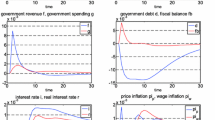Abstract
This paper investigates the dynamic structure of a standard disequilibrium model. By assuming that the model variables are non-stationary time series with respect to ample empirical evidence, we find the following: 1) It is the exogenous variables rather than the price adjustment process that form the real adjustment force of the model; 2) Quantity disequilibrium and price disequilibrium are isomeric in the model, and follow a weakly stationary process when all the variables areI (1) nonstationary; 3) The disequilibrium process has a none-zero mean when the weakly exogenous variables of the demand equation do not cointegrate with those of the supply equation, corresponding to certain 'chronic disequilibrium' phenomena; 4) The isomerism between quantity disequilibrium and price changes makes it unnecessary to lean on the 'min condition' to characterise disequilibrium.
Similar content being viewed by others
References
Ai, C. (1994), 'A semiparametric efficiency bound of a disequilibrium model without observed regime', Journal of Econometrics 62, 143-64.
Artus, P., Avouyi-Dovi, S. and Laffargue, J.-P. (1993), 'A disequilibrium econometric model of the French economy with two sectors and endogenous prices and investment', Economic Modelling 10, 2-10.
Bowden, R. (1978), The Econometrics of Disequilibrium (North-Holland, Amsterdam).
Chang, G.-H. (1992), 'An instrumental variable method of estimation for disequilibrium markets in centrally planned economies', Economic Letters 39, 261-67.
Davis, C. and Charemza, W. (1989), Models of Disequilibrium and Shortage in Centrally Planned Economies, Chapman and Hall Ltd., London.
Dlouhý, V. (1990), 'An equilibrium alternative to a permanent shortage', European Economic Review 34, 340-48.
Engle, R., Hendry, D. and J.-F. Richard (1983), 'Exogeneity', Econometrica 51, 277-304.
Fisher, F. M. (1983), Disequilibrium Foundations of Equilibrium Economics, Cambridge University Press, Cambridge.
Hajivassiliou, V. (1993), 'Macroeconomic shocks in an aggregative disequilibrium model', Cowles Foundation for Research in Economics (mimeo).
Hendry, D. (1995), Dynamic Econometrics, Oxford University Press, Oxford.
Hendry, D. and Richard, J.-F. (1991), 'Likelihood evaluation for dynamic latent variables models', in H. Amman, D. Belsley & L. Pau, eds., Computational Economics and Econometrics, Kluwer Academic Publishers, Dordrecht, chapter I.
Hulyák, K. (1989), 'Macroeconomic disequilibrium model of Hungary', in C. Davis & W. Charemza. eds., Models of Disequilibrium and Shortage in Centrally Planned Economies.
Kornai, J. (1982), Growth, Shortage and Efficiency: A Macrodynamic Model of the Socialist Economy, Basil Blackwell, Oxford.
Laffont, J.-J. and Garcia, R. (1977), 'Disequilibrium econometrics for business loans', Econometrica 45, 1187-204.
Laffont, J.-J. and Monfort, A. (1979), 'Disequilibrium econometrics in dynamic models', Journal of Econometrics 11, 353-61.
Laroque, G. and Salanie, B. (1994), 'Estimating the canonical disequilibrium model: Asymptotic theory and finite sample properties', Journal of Econometrics 62, 165-210.
Li, Y.-N. (1991), China's Disequilibrium Economy (in Chinese), Publishing House of Economic Daily, Beijing.
Maddala, G. (1983), Limited-dependent and Qualitative Variable, Cambridge University Press, Cambridge.
Matsumoto, A. (1994), 'Complex dynamics in a simple macro disequilibrium model', Journal of Economic Behavior and Organization 24, 297-314.
Nelson, C. and Plosser, C.I. (1982). 'Trends and random walks in macroeconomic time series', Journal of Monetary Economics 10, 129-62.
Portes, R. (1989), 'The theory and measurement of macrocosmic disequilibrium in centrally planned economies', in C. Davis & W. Charemza, eds., Models of Disequilibrium and Shortage in Centrally Planned Economies.
Portes, R., Quandt, R., Winter, D. and Yeo, S. (1985), Macroeconomic planning and disequilibrium: Estimates for Poland, 1955-1980', Econometrica 55, 19-42.
Qin, D. (1994), 'Money demand in China: The effect of economic reform', Journal of Asian Economics 5, 253-71.
Qin, D. and Vanags, A. (1996), 'Modelling inflation process in transition economies: Empirical comparison of Poland, Hungary and Czech Republic', Economics of Planning 29, 147-68.
Quandt, R.E. (1988), The Econometrics of Disequilibrium, Basil Blackwell, Oxford.
Salmon, M. (1982), 'Error correction mechanisms', Economic Journal 92, 615-29.
Vich, R. (1987), Z Transform Theory and Applications, D. Reidel Publishing Company, Dordrecht, Holland.
Rights and permissions
About this article
Cite this article
Qin, D., Lu, M. Dynamic Structure of Disequilibrium Models. Economics of Planning 31, 15–27 (1998). https://doi.org/10.1023/A:1003132014211
Issue Date:
DOI: https://doi.org/10.1023/A:1003132014211




